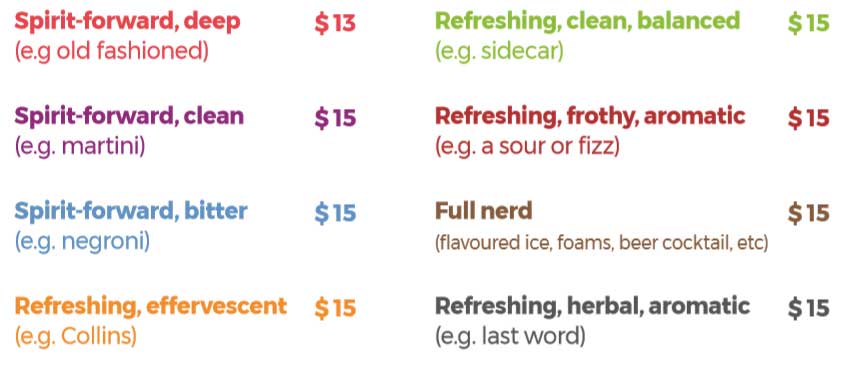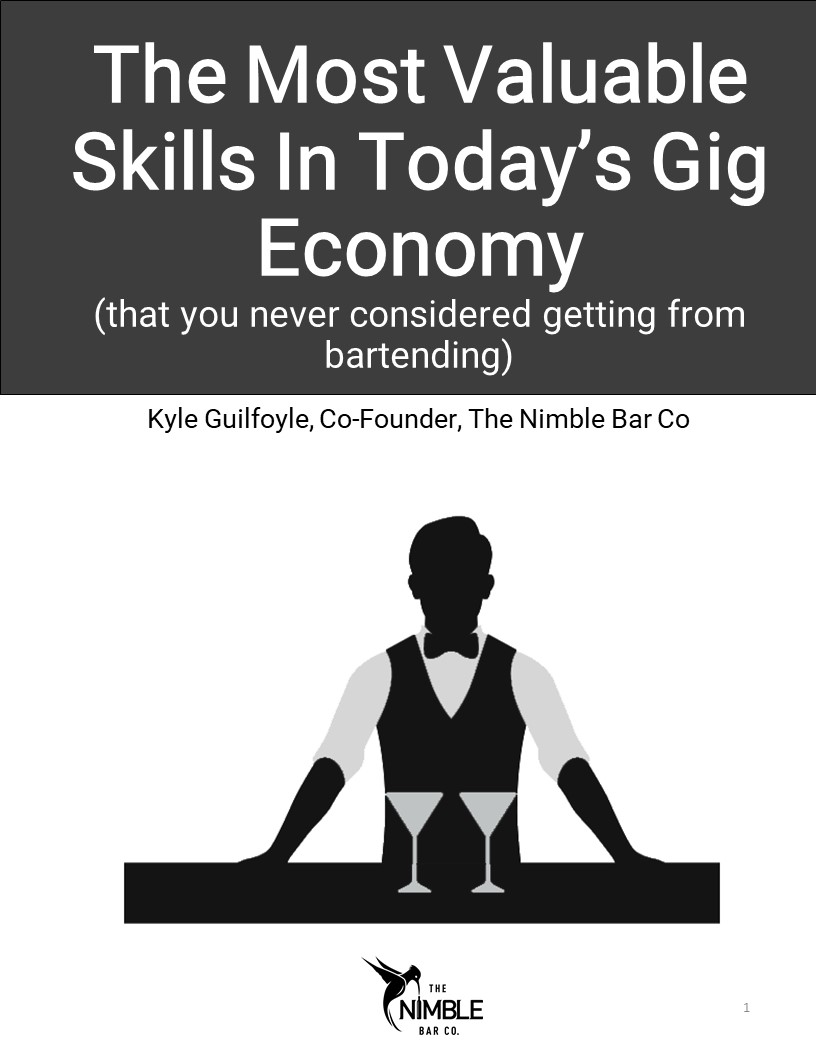How to create a cocktail menu: the fundamentals
Our goal in this guide is to teach you how to create a cocktail menu that both you and your guests will love. We’ll give you the building blocks — the fundamentals of menu development — so you can churn ’em out to your heart’s content. After reading this guide, you’ll know:
- Which ingredients make up the DNA of any cocktail
- Which drinks make up the ‘drink families’ of all modern cocktails
- What makes for great, workable mise en place
- When to source new drinks and rotate out old ones
- How to break down costs and maximize profitability
- What a great menu looks like
Want to download the full guide? Click here!
The DNA of every cocktail
Study the DNA — the recipe, proportions, flavor harmonies — of classic cocktails to train your mind and palate to recognize balance. You can then transfer that sensory knowledge to new sets of ingredients. Here are the components that make up the DNA of cocktails:

- Spirits: Whisky, Rum, Gin, Vodka, Tequila, Mezcal, Brandy, Cachaca, Pisco, Calvados, etc.
- Lengtheners: Fortified wines: Vermouth, Sherry, Port, Quinquina, Madeira, etc.
- Liqueur modifiers: Cointreau, St Germain, Apricot liqueur, Domaine de Canton ginger, etc.
- Amaro modifiers: Aperol, Campari, Fernet Branca, Cynar, Ramazzotti, Averna, etc.
- Sweeteners: Sugar, honey, agave nectar, maple syrup, demerara, etc.
- Acids: Lemon, lime, citric acid, etc.
- Modifying acids: Grapefruit, orange
- Sodas: Soda, ginger beer, tonic water, etc.
- Bitters: Angostura aromatic, Regan’s No. 6 orange, Peychaud’s, Scrappy’s cardamom, etc.
These basic ingredients make up basically every cocktail ever. Get these down to understand drink balance and harmony and to create a cocktail menu that rocks.
The five cocktail families
We’ve identified five classic cocktails (Negroni, Sidecar, Old Fashioned, Sour, and Collins) that influence the creation of 99% of all great cocktails. Learn them well. From these five recipes, you’ll begin to see the underlying DNA at work. You can come up with ‘golden ratios’ that you can use for your own drinks, mixing and matching the parts. Kinda like Mr. Potato Head.
Understand the bones of a good classic to train your mind and palate. You’ll recognize balance and transfer that sense of harmony to a new set of ingredients. Once you’re rooted with proven ratios and ingredient pairings, formulating a new drink will be much easier.

Negroni: 1 oz. spirit, 1 oz. amaro modifier, 1 oz. lengthener – or – 1.5 oz. spirit, 3⁄4 oz. amaro modifier, 3⁄4 oz. lengthener
Sidecar: 1 1/2 oz. spirit, 3/4 oz. liqueur modifier, 3/4 oz. acid
Old Fashioned: 2 oz. spirit, 1/3 oz. sweetener, 4-6 dashes of bitters
Sour: 2 oz. spirit, 1 oz. sweetener 1 oz. acid, 2-4 dashes of bitters egg white
Collins: 2 oz. spirit, 1 oz. acid, 1⁄2 oz. sweetener, 1-2 oz. soda
House-made ingredients
Syrups, tinctures, bitters, and infusions — the creative possibilities are limitless. House-made ingredients are a great way to incorporate cool-factor into your drinks, but you need to be mindful of the cost and prep-time. A good rule of thumb is to limit yourself to one house-made ingredient for every two cocktails on the menu.
Using non-alcoholic ingredients for these custom elements can be a great way to flesh out a drink while keeping costs low.
Learn to batch in bulk, and find non-alcoholic solutions to flesh out your recipes so that the main cost comes from the base spirit. And remember, boutique and bespoke ingredients won’t always improve a drink. For example, sometimes the store-bought falernum is better (and more cost effective).
Mise en place and prep
12 step programs can help you stop drinking or smoking, but they won’t help your behind-the-bar efficiency on a Saturday night. When in service, your goal should always be to limit the number of steps necessary to make a drink. This means you should set up your mise en place so that all your tools and ingredients are within an arm’s if at all possible. It also means you should get rid of clutter.
Consider batching certain cocktails that might be labour intensive or very popular, and use syrups to maximize efficiency.
For example, just about anything you muddle can be made into a syrup. If there’s a cocktail that muddles cucumber and basil, consider making a cucumber and basil syrup instead.
And don’t just create a cocktail; create a curated set of movements that flow beautifully and efficiently. Set yourself up for success. Your station should reflect your professionalism and keep you above board all night, no matter what comes at you. This philosophy eliminates bottlenecks, and also impresses your guests.
Naming inspiration
When you bring your staff together to name cocktails, you grow their camaraderie and their passion for selling. Keep things aligned with the feel and energy of the room, but let the inner nerdiness and authenticity of your team shine though. The name of a cocktail is your customers’ first glimpse of the drink. It’s what your customers see on paper. If you make them laugh, feel special for getting a reference, or salivate from your description, you’re doing it right. Tell a story with each sip to entice customers.
When making up a cocktail on-the-fly, put the onus on your guest to name the drink. This gives him a sense of ownership.
Pars and stock levels
It can be tough at the start to feel out what moves on a new menu. Don’t trust one or two services; anomalies happen. Don’t over-commit to product that will sit around forever. Buy conservatively to start, and if a product takes off, adjust your ordering and prep accordingly.
People often think customers will love tons of choices. Research suggests otherwise. The more choices you present to a customer, the more anxiety and overwhelm you cause them.
Seasons and trends
Know the people who sit at your bar and dine in your restaurant. Don’t try and push passionfruit juice and rhubarb smashes when it is cold & shitty outside and people are craving something to warm them up. Offer a good mix of safe & sell-wells, along with some nerdier options to flex the niche of your establishment. But don’t take your drink program too seriously; cocktails are supposed to be fun and inviting, after all.
Have you ever heard the saying ‘the trend is your friend’? Well it’s absolutely true. We often see bartenders banging their heads against the wall trying to come up with the next big thing. But from a business standpoint, something that is currently trending is something that simply works.
When creating new drinks, we love to start with the classics and imbue them with seasonality. For example, a fig and winter-spiced negroni variation in the winter and a watermelon collins in the summer.
Sourcing and rotation
While you want to imbue your drinks with seasonality and source fresh as much as possible, you don’t need to go on a grand excursion out to the middle of nowhere to forage for ingredients. Sometimes you can simply have a gander at what’s inside your walk-in fridge. Not sure what’s in-season? Your chef can be a phenomenal resource to help you out. He / she can also provide ideas for flavour pairings.
And if you don’t have unlimited access to a chef, pick up a copy of The Flavor Bible.
Funky, weird ingredients help a new menu pop and get people talking. BUT, when your supplier no longer carries your funky ingredient and you have to 86 it a week after launching, that doesn’t look good. Take a trip through your walk-in, or have a talk with your chef to come up with ways to move existing overstock that’s just sitting latent. You’ll make the bosses happy and increases the bottom line for the establishment.
Costing
If you know exactly what a drink costs to make, you’ll focus more on the profitability of that drink. While bars and restaurants can provide romance — and we’re there to provide a beautiful experience — we’re there to generate profit FIRST.
Often, when people realize that the cost of a cocktail’s ingredients is only $2.00 – $4.00, they wonder why the markup is 100%-300%. But that drink pays for a lot of other expenses. Here are some of them:
- Rent
- Glassware
- Labour
- Garnish
- Ice
- Tools
- Cocktail napkins, etc.
Cost breakdown of a classic margarita
Ingredients | Cost |
2 oz. El Jimador Reposado | $2.32 |
3/4 oz. Cointreau | $0.99 |
1 oz. Lime juice | $0.65 |
| 1/4 oz. Agave nectar | $0.11 |
Cost to restaurant: $4.07
Price to customer: $12.00
Pour cost: 34%
What this means: To earn one dollar on a margarita, the restaurant must first spend 34 cents.
But there’s a bit more to it. Let’s say that a classic margarita takes 1 minute for a bartender to prepare. And, of course, the drink will be served in a glass, probably with a napkin… Here are the other costs that eat away at a bar’s profit margins:
Other expenses | Cost |
Cocktail napkin | $0.03 |
Labour (bartender only, based on $11.00/hour) | $0.18 |
| Rent per hour | $0.18 |
TOTAL cost to restaurant = $4.46
ACTUAL cost as proportion of price= 38%
Cost breakdown of a Hidalgo La Gitana Manzanilla pour

If you give your team a glimpse of the business side of the glass, they’ll think more like owners and managers. Break down the costs of the crazy orchid garnish or the 3 oz., 7 ingredient tiki drink. Sometimes you can feel like a kid in a candy store when selecting ingredients for your new menu cocktail… but remember, the place still needs to make money.
An example menu template

Cocktail Menus and the paradox of choice
Many establishments make menus that have more than 10 cocktails. People often think customers will love tons of choices. Research suggests otherwise. The more choices you present to a customer, the more anxiety and overwhelm you cause them. People simply don’t want to make decisions because making decisions is mentally taxing. Aim for a curated, lean, and well-rounded cocktail menu.
There you have it!
The foundations you need to create a great cocktail menu. Don’t forget to download the guide
if you haven’t already!







